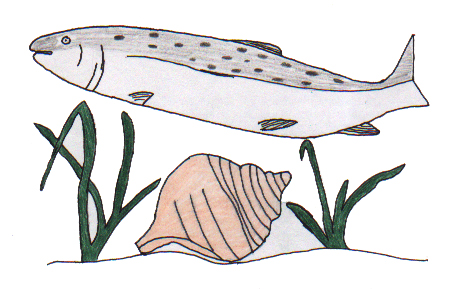 Marshall
Cultural Atlas Marshall
Cultural Atlas
This collection of student work is from
Frank Keim's classes. He has wanted to share these works for others
to use as an example of Culturally-based curriculum and documentation. These
documents have been OCR-scanned. These are available
for educational use only.

Dolly Varden
(Salvelinus malma)
(lqallugpik)
Dolly Varden are found in most coastal waters of
Alaska from Southeastern to the tip of the Aleutian Chain and into
the Bristol Bay area.
A young Dolly Varden has about 8 to 10 dark oval
blotches on the dorsal suface and numerous red to orange spots on its
sides. The mature males become bright red on the lower body surface,
and the lower fins become reddish-black with white along the leading
edges. Males develop an extended lower jaw which hooks upward. A hook
also forms in the females, but is less developed.
The Dolly Varden belongs to a group of fish called
chars. They spawn in streams, usually during the fall in October and
November. The female, depending on the size, may deposite 600 to 6000
eggs. When the female is ready to deposit her eggs, the male moves to
her side and spawning begins. The sperm and eggs are released
simultaneously into the redd or gravel nest.
The eggs develop slowly in the cold water
temperatures. The eggs may hatch in March, four to five months after
fertilization. The young Dolly Varden stay in streams before
beginning their first migration to the sea in their third or fourth
year. At this time they are about five inches long. This migration
usually occurs in May or June.
At ages five and six they may reach 12 to 16
inches long and weigh from 0.5 to 1 pound. It is doubtful that many
more than 50 per cent of the Dolly Varden live to spawn a second
time. Few Dolly Varden appear to live longer than eight years. The
maximum size for most Dollys is between 15 and 22 inches and from 1
to 3 pounds.
Cheryl
Hunter
Christmastime Tales
Stories real and imaginary about Christmas, Slavik, and the New Year
Winter, 1996 |
Christmastime Tales II
Stories about Christmas, Slavik, and the New Year
Winter, 1998 |
Christmastime Tales III
Stories about Christmas, Slavik, and the New Year
Winter, 2000 |
| Summer Time Tails 1992 |
Summertime Tails II 1993 |
Summertime Tails III |
| Summertime Tails IV Fall, 1995 |
Summertime Tails V Fall, 1996 |
Summertime Tails VI Fall, 1997 |
| Summertime Tails VII Fall, 1999 |
Signs of the Times November 1996 |
Creative Stories From Creative Imaginations |
| Mustang Mind Manglers - Stories of the Far Out,
the Frightening and the Fantastic 1993 |
Yupik Gourmet - A Book of
Recipes |
|
| M&M Monthly |
|
|
| Happy Moose Hunting! September Edition 1997 |
Happy Easter! March/April 1998 |
Merry Christmas December Edition 1997 |
| Happy Valentine’s
Day! February Edition
1998 |
Happy Easter! March/April Edition 2000 |
Happy Thanksgiving Nov. Edition, 1997 |
| Happy Halloween October 1997 Edition |
Edible and Useful Plants of Scammon
Bay |
Edible Plants of Hooper Bay 1981 |
| The Flowers of Scammon Bay Alaska |
Poems of Hooper Bay |
Scammon Bay (Upward Bound Students) |
| Family Trees and the Buzzy Lord |
It takes a Village - A guide for parents May 1997 |
People in Our Community |
| Buildings and Personalities of
Marshall |
Marshall Village PROFILE |
Qigeckalleq Pellullermeng ‘A
Glimpse of the Past’ |
| Raven’s
Stories Spring 1995 |
Bird Stories from Scammon Bay |
The Sea Around Us |
| Ellamyua - The Great Weather - Stories about the
Weather Spring 1996 |
Moose Fire - Stories and Poems about Moose November,
1998 |
Bears Bees and Bald Eagles Winter 1992-1993 |
| Fish Fire and Water - Stories about fish, global warming
and the future November, 1997 |
Wolf Fire - Stories and Poems about Wolves |
Bear Fire - Stories and Poems about Bears Spring,
1992 |
|